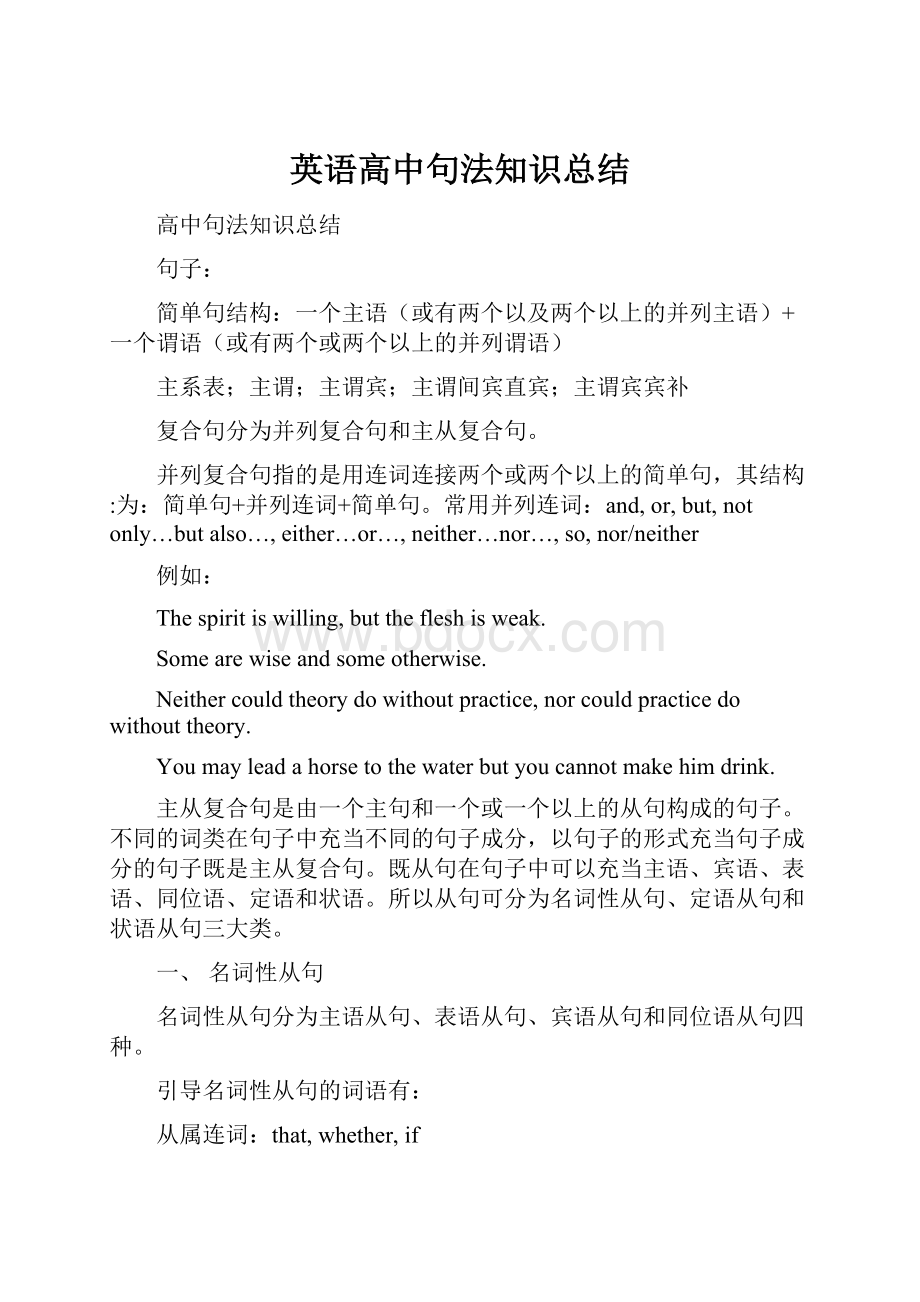英语高中句法知识总结.docx
《英语高中句法知识总结.docx》由会员分享,可在线阅读,更多相关《英语高中句法知识总结.docx(22页珍藏版)》请在冰豆网上搜索。

英语高中句法知识总结
高中句法知识总结
句子:
简单句结构:
一个主语(或有两个以及两个以上的并列主语)+一个谓语(或有两个或两个以上的并列谓语)
主系表;主谓;主谓宾;主谓间宾直宾;主谓宾宾补
复合句分为并列复合句和主从复合句。
并列复合句指的是用连词连接两个或两个以上的简单句,其结构:
为:
简单句+并列连词+简单句。
常用并列连词:
and,or,but,notonly…butalso…,either…or…,neither…nor…,so,nor/neither
例如:
Thespiritiswilling,butthefleshisweak.
Somearewiseandsomeotherwise.
Neithercouldtheorydowithoutpractice,norcouldpracticedowithouttheory.
Youmayleadahorsetothewaterbutyoucannotmakehimdrink.
主从复合句是由一个主句和一个或一个以上的从句构成的句子。
不同的词类在句子中充当不同的句子成分,以句子的形式充当句子成分的句子既是主从复合句。
既从句在句子中可以充当主语、宾语、表语、同位语、定语和状语。
所以从句可分为名词性从句、定语从句和状语从句三大类。
一、名词性从句
名词性从句分为主语从句、表语从句、宾语从句和同位语从句四种。
引导名词性从句的词语有:
从属连词:
that,whether,if
疑问代词:
who,which,whose,what
疑问副词:
when,where,how,why
关系代词:
what(thethingsthat),whatever(anythingthat),whoever(anybodywho),whichever
1.主语从句
以句子的形式在句子中充当主语,例如:
Thatthingswillimproveisobvious.
Whetherhe’scoming(ornot)doesn’tmatterverymuch.
Whosaidthatisnotimportant.
Whichoneiscorrectishardtosay.
Whosesidesheisonisnotquiteclear.
Whatmadehimdosoisamystery.(what做疑问代词)
Whatmattersmostisgoodhealth.(what做关系代词)
Whenandwherethemeetingwillbeheldisnotyetfixed.
Howshegotwoundedatworkshouldbeinvestigated.
Whyweshoulddevelopeducationisnotaquestion.
Whoeversaidthatwaslying.
Whateveryougiveisfinewithme.
Whicheverofyougainsthemostpointswinsthecompetition.
Notes:
a)主语从句前面的that不能省略。
主语从句虽然可以位于主句谓语动词之前,但多数情况下用先行词it作形式主语,将that(包括其他引导词引导的)主语从句后置。
在后置的主语从句中,that常可省略。
例如:
Itisyourownconcernwhetheryoubelievemeornot.
Itdoesn’tmattermuchwhodoesitaslongasitisdone.
Itissurprisinghowmanyunhappymarriagesthereare.
Itisamysterywhatheseesinher.
Itwasn’tveryclearwhatshemeant.
b)whether和if的用法应有所区别:
引导主语从句、表语从句和介词后面的宾语从句时,必须用whether;引导动词后面的宾语从句和否定结构的“be+形容词+宾语从句”(如notcertain,notsure等)的时候,whether和if两者都可。
但是,discuss等动词后的宾语从句用whether引导而不用if。
如果对这两个从属连词没有把握,用whether为宜。
c)what既可以作疑问代词,也可以作关系代词,用法和意义大为不同。
作疑问代词时,what表示“什么”,作关系代词时,what表示“所……的”,相当于“thethingsthat……”
例如:
Whatweshalldodependsonyou.
Whatmaybedoneatanytimeisdoneatnotime.(=Thethingthatmaybedoneatanytimeisdoneatnotime.)
d)whatever,whoever和whichever称为复合关系代词。
Whoever的宾格形式还是whoever,不用whomever。
Whatever,whoever,whichever的其他用法见“状语从句”部分。
2.宾语从句
名词性质的词类在句中可以做谓语动词的宾语,非谓语动词的宾语以及介词的宾语,名词性从句亦然。
例如:
Hetoldme(that)thematchhadbeencancelled.谓语动词后
Themanagerobjectedthatitwasimpossible.谓语动词后
Hearing(that)hefailedtheexamination,hecried.现在分词后
Todowhatwearerequiredtodoisnecessary.不定式后
Itisgoodaskingwhyandhowchangedaremade.动名词后
Hewilltalktousaboutwhathehasexperienced.介词后
Weareglad(that)youcanattendourparty.形容词后
I’minterestedinhowhedidit.介词后
Prisonershavetoeatwhatevertheyaregiven.谓语动词后
I’llgivemytickettowhoeverwantsit.介词后
Astrawwillshowwhichwaythewindblows.谓语动词后
a)在较为常用的动词后引导宾语从句的that可以省略,但是,在较为正式和不常用的动词后引导宾语从句的that不可以省略。
如上述第一和第二例。
一般不省略宾语从句中的从属连词that的动词有:
accept,acknowledge,add,advertise,affirm,allege,appreciate,answer,argue,assert,certify,charge,check,confirm,disagree,dream,emphasize,ensure,exclaim,forecast,imply,indicate,note,observe,predict,record,remark,repeat,reply,report,respond,show,state,teach,vote,write,等。
b)“be+形容词+that从句”的结构中的形容词往往是afraid,glad,happy,pleased,sorry等表示个人感情色彩和certain,sure等表示确信意义的形容词。
在这一结构中,that可以省略。
c)动词+介词(短语动词)和be+形容词+介词的结构不能跟that引导的宾语从句(即that引导的宾语从句不能位于介词之后)。
但,疑问词引导的宾语从句可以放在介词之后。
如:
Heboastedabouthissuccess.
Heboastedthathewassuccessful.
Heboastedabouthowsuccessfulhewas.
Itdependsonwhetherheiswillingtoundertakeit.
Weareinterestedinwhatyouaredoing.
3.表语从句
表语从句是以句子的形式来充当表语。
表语从句如果是一个陈述句,其引导词that不能省略。
例如:
Thequestioniswhetherwecanunderstandthemeaningofhisremarks.
Thisiswhyhehadadayoffyesterday.
Myideaisthatyoushouldtakethismatterintoreconsideration.
Thatwaswhatwearebadlyinneedof.
Theproblemiswhocanundertakethisresponsibility.
4.同位语从句
补充说明名词、名词短语或代词的名词以及名词短语称为同位语。
起相同作用的从句形式称为同位语从句。
同位语从句的特点是:
从句由that引导,一般位于抽象名词之后,说明抽象名词所包含的具体内容、含义是什么。
例如:
Hisdelayofanhourisduetothefactthathedidnotcatchthetrain.
Mostteacherssharetheopinionthatthemajorityofthefreshmenarepromising.
a)同位语从句在形式上与定语从句非常相似。
但是,其性质完全不同。
同位语从句和定语从句的主要区别在于:
同位语从句只能用that,不能用which来引导;同时that在句子中不充当任何句子成分,只起到标示同位语的作用。
而定语从句一般情况下既可以用that也可以用which来引导,无论是that还是which都是关系代词,在定语从句中充当句子的主语或宾语。
如以下对比:
Heputforwardthesuggestionthatthematterbebroughtupatthenextmeeting.
Thesuggestionthatheputforwardatthemeetingwasturneddown.
Hewaspreparedtoprovehistheorythattwodifferentweights,droppedsimultaneouslyfromthesameheight,wouldfalltothegroundatthesametime.
GalileofavoredCopernicus’theorywhichdeclaredthattheearthisaplanetwhichrevolvesaroundafixedsun.
b)常带同位语从句的名词:
belief,conviction,doubt,explanation,fact,fear,feeling,guarantee,hope,idea,indication,message,news,opinion,order,proof,rumor,suggestion,thought,wish
例如:
WemustkeepthisbasicfactinmindthatEnglishandChineseascarriersofdifferentculturesarevastlydifferent.
Yourfearthatyoucan’tlearnEnglishwellisentirelygroundless.
Ihavethefeelingthatmostoftheoldpeopledonotlikethewaysomeyoungpeoplebehavenowadays.
EverybodywasdelightedatthethoughtthatweshallsoonbegoingtoTibetforavisit.
c)“…thefactthat…”的结构也可以用于accordingto,apartfrom,asfor/to,asfrom,asregards,asaresultof,becauseof,butfor,bycomparisonwith,despite,dueto,exceptfor,forthesakeof,inadditionto,inconnectionwith,incomparisonto/with,inlinewith,inspiteof,insteadof,inviewof,onaccountof,regardlessof,upto,withtheexceptionof,withreferenceto,withregardto,notwithstanding等介词或介词短语之后。
例如:
Inspiteof/Despitethefactthathotelpriceshaverisensharply,thenumberoftouristsisasgreatasever.
二、定语从句
复合句中修饰名词、名词短语或代词的从句叫做定语从句。
被定语从句修饰的名词、名词短语或代词称为先行词。
定语从句在句中所起的作用与形容词所起的作用是一样的,所以定语从句又可以称为形容词从句。
另外,定语从句是借助关系代词或关系副词与句子中被修饰的成分发生关系的,所以又被成为关系从句。
定语从句可以用于修饰和形容人、事、物。
引导定语从句的可以是关系代词,也可以是关系副词。
关系代词在定语从句中作主语和宾语;关系副词在定语从句中作状语。
关系代词:
指人:
who,that(主格)/who,whom,that(宾格)/whose(所有格)
指物:
which,that(主格)/which,that(宾格)/whose,ofwhich(所有格)
关系副词:
when(=介词+which),where(=介词+which),why(=介词+which),as/inwhich;that
1.限制性定语从句和非限制性定语从句
限制性定语从句是一个句子中不可分割的组成部分。
如果没有该定语从句,先行词的意思就会不明确,主句就会不完整。
非限制性定语从句是对主句中先行词的补充说明。
如果没有该定语从句,主句的意思依然完整,不受影响。
二者的主要区别在与逗号的使用。
例如:
Hehastwobrotherswhoarecollegestudents.
Hehastwobrothers,whoarecollegestudents.
Thetravelerswhoknewaboutthefloodstookanotherroad.
Thetravelers,whoknewaboutthefloods,tookanotherroad.
Hetorethephotothatupsetme.
Hetorethephoto,whichupsetme.
a)限制性定语从句一般不用任何方式与主句分割开来。
说话时不停顿,书写时无逗号。
非限制性定语从句经常与主句分割开来。
说话时需停顿,书写时用逗号。
但是,并非所有的定语从句都作如此严格的区分,在不影响句子基本意思的情况下,在句子的意思不至于引起误解的时候,使用逗号与否,可由作者自行定夺。
b)非限制性定语从句比较正式,多用语书面语。
非限制性定语从句中,不能用关系代词that,而且关系代词不能省略。
例如:
Igavehimathickbook,whichhereadimmediately.
Iwenttoseetheirnewhouse,whichIlikedverymuch.
YesterdayImetmyoldclassmate,whowasverypleasedtoseeme.
c)非限制性定语从句中的介词位置比较灵活。
正式文体中,一般位于关系代词之前,其他情况下可以位于从句的末尾。
如果从句修饰的是“人”,关系代词作宾语时常常用whom而不用who.
例如:
Ihavefoundaman,whomyoucansafelydependon.
Thesmallmanintheraincoat,whomnobodyrecognized,turnedouttobeherfirsthusband.
d)如果先行词在句子中已经由形容词性的物主代词或指示代词作了明确的说明,则不能再使用限制性定语从句来修饰。
这时,须使用非限制性定语从句。
但如果把指示代词换成定冠词,则可使用限制性定语从句。
例如:
MybookwhichIboughtyesterdayisveryinteresting.(x)
ThisbookwhichIboughtyesterdayisveryinteresting.(x)
Mybook,whichIboughtyesterday,isveryinteresting.(√)
ThebookwhichIboughtyesterdayisveryinteresting.(√)
e)限制性定语从句中,先行词如果是something,everything,anything,nothing,all,none,few,afew,little,alittle等词语,或者由some,every,any,no,all,few,afew,little,alittle,only等词语以及形容词的最高级形式修饰的时候,限制性定语从句用关系代词that引导,表示人的时候,用who引导。
例如:
Thereisnothingthatcostslessthancivility.
Theonlythingthatmattersistofindawayoutofthetrouble.
Haveyougotanythingthatbelongstome?
Isthatallthatyouhavedone?
Thelittlethatyouhavesaidisofmuchhelptous.
f)非限制性定语从句中,可以用“不定代词/数量词/形容词最高级+ofwhom/which”的结构,表示数量或某种特点。
all,each,both,either,neither,none,little,few,many,much,some,most,any和majority,half,several,enough,anumberof等词语都可以用于这种结构。
例如:
Afterclass,heaskedmemanyquestions,someofwhichweredifficulttoanswer.
Twostudentsoftheclass,neitherofwhomstudiedhard,failedthefinalexam.
Hehasfivechildren,theyoungestofwhomisstudyingEnglish.
g)which引导的非限制性定语从句还可以指前面的整个主句或主句的一部分,说明其情况如何。
这时的which相当于andthis或andthat。
此外,inwhichcase,atwhichpoint,onwhichoccasion等短语中的which同样说明前面整个主句(或部分)的情况。
例如:
Theysaidshemarriedherstudent,whichwasnottrue.
Heleftthejobfornothing,whichannoyedhisparents.
Imaybeabitlateforthemeetingthisafternoon,inwhichcaseIwilltelephone.
Hechangedhismind,atwhichpointalltheothersdecidedtoleavehimalone.
另外,非限制性定语从句有时并不修饰先行词,而是用语保持叙述的连贯性,表示时间先后,因果关系,并列或转折的意思,相当于“and/but+主语”的形式。
如:
Ilentthebooktomyroommate,wholentittohisgirlfriend.(who=andhe)
Iturnedtohimforhelp,whosaiditwasnothisbusiness.(who=buthe)
h)定语从句可以用同位语,非谓语动词(不定式,动名词,现在分词,过去分词),“介词+关系代词+不定式”(非常正式),“不定式+介词”的形式来进行缩略。
例如:
MrWu,whoisaclassmateofmine,nevermissestheopportunitytotellmethelatestnews.
MrWu,aclassmateofmine,nevermissestheopportunitytotellmethelatestnews.
Youaretheonlypersonwhocanunderstandhismeaning.
Youaretheonlypersontounderstandhismeaning.
Thosewhoexpecttopasstheexaminationmustworkhard.
Thoseexpectingtopasstheexaminat